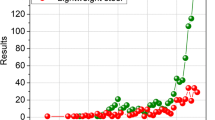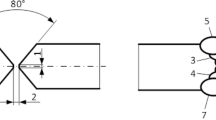Abstract
The main concepts of the fatigue limit of metallic materials are considered. Results of cyclic tests of various steels and copper in the range of high-cycle and gigacycle fatigue are presented. Special features of the respective fatigue curves are discussed. Problems of initiation of fatigue cracks in various domains of cyclic deformation and of existence of a secondary fatigue limit in the range of gigacycle fatigue are considered.
Similar content being viewed by others
REFERENCES
W.-W. Maenning and H.-J. Taferner, "Ursachen der Ausbildung einer Dauerschwingfestigkeisgrenze bei kubischraumzentrierten, kubischflachenzentrierter und hexagonal dichtest gepackten metallen," VDI Foschungsheft, No. 611, 1–39(1982).
A. Ferro and G. Montalenti, "Fatigue of pure iron containing a small quantity of carbon after strain aging," Philosoph. Mag., 8(85), 105–119 (1963).
V. F. Terent'ev, Fatigue Strength of Metals and Alloys [in Russian], Intermet Engineering, Moscow (2002).
V. F. Terent'ev, Fatigue of Metallic Materials [in Russian], Nauka, Moscow (2002).
T. Ekobori, The Physics and Mechanics of Fracture and Strength of Solids [Russian translation], Metallurgiya, Moscow (1971).
V. T. Troshchenko and L. A. Sosnovskii, Fatigue Resistance of Metals and Alloys, Part 1 [in Russian], Naukova Dumka, Kiev (1987).
GOST 25.502-79, Methods of Mechanical Tests. Methods of Fatigue Tests [in Russian], Izd. Standartov, Moscow (1986).
T. Nakamura, M. Kaneko, T. Noguchi, and K. Jinbo, "Relation between high cycle fatigue characteristics and fracture origins in low temperature tempered Cr-Mo steel," Trans. Jap. Mech. Eng. A, 64(623), 68–73 (1998).
I. E. Kolosov and T. A. Lebedev, "Cyclic strength of hardened tool steels," Metalloved. Term. Obrab. Met., No. 10, 15–19 (1962).
Q. Y. Wang, G. Baudry, C. Bathias, and J. Y. Berard, "Subsurface crack initiation due to ultra-high cycle fatigue," in: Advances in Mechanical Behavior, Plasticity and Damage, Proc. EUROMAT 2000, Amsterdam-Lausanne, Vol. 2, Elsevier, New York (2000), pp. 1083–1087.
K. Shiozawa, L. Lu, and S. Ishihara, "S-N curve characteristics and subsurface crack initiation behavior in ultra-long life fatigue of high carbon-chromium bearing steel," Fatigue Fract. Eng. Mater. Struct., 24(12), 781–790 (2001).
K. Shiozawa, L. Lu, and S. Ishihara, "Duplex S-N characteristics and subsurface fatigue crack initiation behavior in high carbon-chromium bearing steel," in: Proc. 13th Europ. Conf. of Fracture 2000, San Sebastian, Spain, Elsevier Science (2000), pp. 103–111.
Y. Furuya, S. Matsuoka, T. Abe, et al., "Effect of frequency on giga-cycle fatigue properties for low temperature tempered SNSM 439 steel," Trans. Jap. Soc. Mech. Eng. A, 68(667), 477–483 (2002).
L. V. Konovalov and I. M. Petrova, "Special features of cyclic strength of structural steels in the domain of long-term endurance," Vestn. Mashinostr., No. 9, 3–11 (1998).
H. Mughrabi, "On "multi-stage" fatigue life diagrams and the relevant life-controlling mechanisms," in: Proc. Int. Conf. on "Fatigue in the Very High Cycle Regime" 2-4 July, 2001, Vienna, Austria, Inst. of Meteorol. and Physics Austria (2001), pp. 35–49.
H. Zhang and J. Sun, "Change in density of a-Fe during healing of internal fatigue microcracks under annealing," Acta Met., 39(4), 351–354 (2003).
Y. Furuja and S. Matsuoka, "Improvement of gigacycle fatigue properties by modified ausforming in 1600 and 2000 MPa-class low-alloy steels," Metallurg. Mater. Trans. A, 33A, November, 3421–3431 (2002).
Y. Murakami, M. Takada, and T. Toriyama, "Super-long life tension-compression fatigue properties of quenched and tempered 0.46% carbon steel," Int. J. Fatigue, 16, 661–667 (1998).
S. Nishijiama and K. Kanasawa, "Stepwise S-N curve and fish-eye failure in gigacycle regime," Fatigue Fract. Eng. Mater. Struct., 22, 601–607 (1999).
C. Bathias, "There is no infinite fatigue life in metals," Fatigue Fract. Eng. Mater. Struct., 22, 559–565(1999).
T. Sakai, M. Takeda, K. Shiozawa, et al., "Experimental evidence of duplex S-N characteristics in wide life region for high strength steels," in: FATIGUE 99, Proc. 7th Int. Fatigue Congr., Higher Education Press, Beijing and FMAS, West Midlands, Vol. 1 (1999), pp. 573–578.
Q. Y. Wang, C. Bathias, S. Rathery, and J. Y. Berard, "Comportement en fatigue gigacyclique d'une fonte GS," Rev. Met. (Fr.), 96(2), 221–226 (1999).
P. Lucas and L. Kunz, "Specific features of high cycle and ultra-high cycle fatigue," in: Proc. Int. Conf. on "Fatigue in the Very High Cycle Regime," 2-4 July, 2001, Vienna, Austria, Inst. Meteorol. and Physics Austria (2001), pp. 23–32.
V. F. Terent'ev, "Processes of micro-and macroscopic deformation of metallic materials below the fatigue limit," Metally, No. 5, 1–8 (2003).
Y. Murakami, "Mechanism of fatigue failure in ultralong life regime," in: Proc. Int. Conf. on "Fatigue in the Very High Cycle Regime," 2-4 July, 2001, Vienna, Austria, Inst. Meteorol. Physics Austria (2001), pp. 12–21.
R. Murakami, D. Yonekura, and Z. Ni, "Fatigue fracture behavior of high strength steel in super long life range," JSME Int. J., Ser. A, 45(4), 517–522 (2002).
O. Umezawa and K. Nagai, "Subsurface crack generation in high cycle fatigue for high strength alloys," ISIJ Int., 37(12), 1170–1179 (1997).
H.-J. Spies and P. Trubitz, "Ermüdungsverhalten nitrierter Stähle," Härter-Techn. Mitt., 51(6), 378–384 (1996).
V. S. Ivanova, V. A. Kobzev, and V. F. Terent'ev, "A study of cyclic fracture toughness of steel 45 and choice of optimum surface hardening treatment," in: Cyclic Fracture Toughness of Metals and Alloys [in Russian], Nauka, Moscow (1981), pp. 107–126.
V. S. Ivanova, V. F. Terent'ev, V. A. Kobzev, and T. Yokobori, "Investigation on the cycle fatigue toughness of surfacestrengthened structural steel," in: Rep. Res. Inst. Strength and Fracture of Materials, Tohoku Univ., Vol. 15, No. 1, May(1980), pp. 1–8.
M. Nakajima, K. Tokaji, H. Itoga, and H.-N. Ko, "Morphology of stepwise S-N curves depending on work-hardened layer and humidity in a high strength steel," Fatigue Fract. Eng. Mater. Struct., 26(12), 1113–1118 (2003).
N. Limodin, Y. Verreman, and T. N. Tarfa, "Axial fatigue of gas-nitrided quenched and tempered AISI 4140 steel: effect of nitriding depth," Fatigue Fract. Eng. Mater. Struct., 26(9), 811–820 (2003).
T. Abe, Y. Furuya, and S. Matsuoka, "Gigacycle fatigue properties of 1800 MPa class spring steels," Fatigue Fract. Eng. Mater. Struct., 27(2), 159–167 (2004).
Author information
Authors and Affiliations
Rights and permissions
About this article
Cite this article
Terent'ev, V.F. On the Problem of the Fatigue Limit of Metallic Materials. Metal Science and Heat Treatment 46, 244–249 (2004). https://doi.org/10.1023/B:MSAT.0000043111.07884.3b
Issue Date:
DOI: https://doi.org/10.1023/B:MSAT.0000043111.07884.3b




